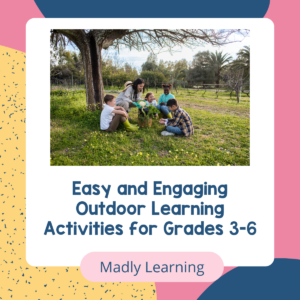When it comes to creating an effective literacy routine, the first step is all about consistency. A structured routine not only benefits your students but also helps you feel organized and in control of your language arts block. Whether you’re starting from scratch or looking to refine your current routine, building a strong foundation for literacy can make a world of difference. Let’s break down how to create a literacy routine that works for both you and your students.

Establishing a Routine in the Classroom
The first key to setting up your literacy program is establishing routines and structures that your students can follow. This is crucial whether you’re starting in September or midway through the year. A clear routine helps everyone understand what’s expected, reduces chaos, and fosters a sense of security in the classroom.
A well-thought-out routine provides a consistent framework for lessons and activities. It allows you to plug in lessons systematically, ensuring that everything fits neatly into the schedule. Over time, this structure helps your students know what to expect each day, which leads to smoother transitions and more focused learning.
Building Relationships and Trust
A successful literacy routine doesn’t just focus on the academic side; it’s also about building relationships with your students. When students feel connected to you, they’re more likely to engage and take risks in their learning. That’s why, at the beginning of your literacy program, focus on establishing rapport, trust, and a supportive classroom environment. Taking the time to connect with your students and gather diagnostic information at the start will pay off in the long run.
The Components of a Strong Literacy Routine
Now that we’ve talked about the importance of structure and relationships, let’s look at the practical elements that make up a literacy routine. Here’s how to break down your time to maximize effectiveness:
1. Warm-Up Activity (5-10 minutes)
Every day should start with a quick warm-up to get students in the right mindset for learning. This could be independent reading, a center rotation, or a short bell work activity that focuses on skills relevant to the day’s lessons.
2. 25-Minute Teacher-Led Lesson
Next comes your main lesson, which will typically last around 25 minutes. During this time, focus on specific areas like spelling, grammar, or vocabulary. For example, on the first day of the week, you might prioritize spelling lessons, which will set the foundation for your other activities. By incorporating shared reading and vocabulary activities, you can integrate multiple skills into one focused lesson.
3. 15-Minute Center Activity
After your lesson, it’s time for a student-centered activity. This can be a practice task that reinforces the lesson’s content, such as independent reading, a writing prompt, or a game related to the skills taught. Centers allow for personalized learning and give you a chance to work with small groups.
4. Another Teacher-Led Lesson
Following your center activity, offer another 25-minute lesson, either continuing the same focus from earlier or introducing a new skill. This reinforces the concepts while ensuring students get a variety of learning experiences throughout the week.
Weekly Structure Breakdown
Your literacy routine will look different each day of the week as you balance lessons and independent work. Here’s how you can break down your week:
Monday: Focus on Spelling, Vocabulary, and Shared Reading
Start the week with a spelling lesson, tying in vocabulary and shared reading. This will give students the tools they need for the week’s activities.
Tuesday: Read-Aloud and Grammar
On Tuesday, move into a read-aloud session, focusing on comprehension strategies that you’re working on. Following that, dive into a grammar lesson that complements the other lessons, ensuring a solid foundation for independent practice.
Wednesday to Friday: Comprehension, Writing, and Text Analysis
In the latter half of the week, focus on reading comprehension, text analysis, and writing. Revisit the shared reading text from Monday and dig deeper into its meaning. Thursday and Friday are perfect for writing lessons, where you’ll emphasize brainstorming, drafting, and refining student writing.
Teaching the Writing Process
Writing can be one of the most challenging aspects of literacy, but it’s also where a lot of growth happens. Instead of focusing solely on traditional writing forms, make sure to emphasize the writing process. Start by helping students generate ideas, then move into drafting, refining, and eventually editing.
At the beginning of the year, help students brainstorm and organize their thoughts. As the year progresses, focus on developing deeper drafts and complex writing. By the end of the year, students should be more confident in editing and revising their work. Throughout this process, remember that the goal isn’t perfection but consistent practice and improvement.
Building Independent Work Skills
Your literacy routine should also incorporate time for independent work, where students can apply what they’ve learned on their own. Whether it’s through writing assignments or comprehension exercises, giving students space to work independently helps them build confidence and self-sufficiency. You can incorporate up to 15 minutes of independent work time where students complete tasks based on the lessons.
Flexibility and Adaptation
While it’s important to have a routine, flexibility is key. Not every classroom has the same amount of time or the same student needs. If you find you have less time for literacy, don’t be afraid to adjust your schedule accordingly. It’s not about sticking rigidly to one structure but about creating a repeatable, sustainable routine that works for you and your students. Even if you need to adjust your schedule slightly, the goal is to maintain a consistent routine that everyone can follow.
Conclusion
Creating a strong literacy routine is all about structure, consistency, and relationships. By setting up a clear routine, building trust with your students, and gradually introducing lessons, you’ll be setting them up for success. Adapt your schedule to meet your students’ needs, and over time, your literacy block will run smoothly, giving both you and your students a sense of organization and confidence.
With a strong literacy routine in place, you’ll be well-equipped to help your students grow as readers and writers throughout the year. You may also want to check out this blog post Maximizing Your 60 Minute Literacy Block: Effective Strategies for Teachers!






